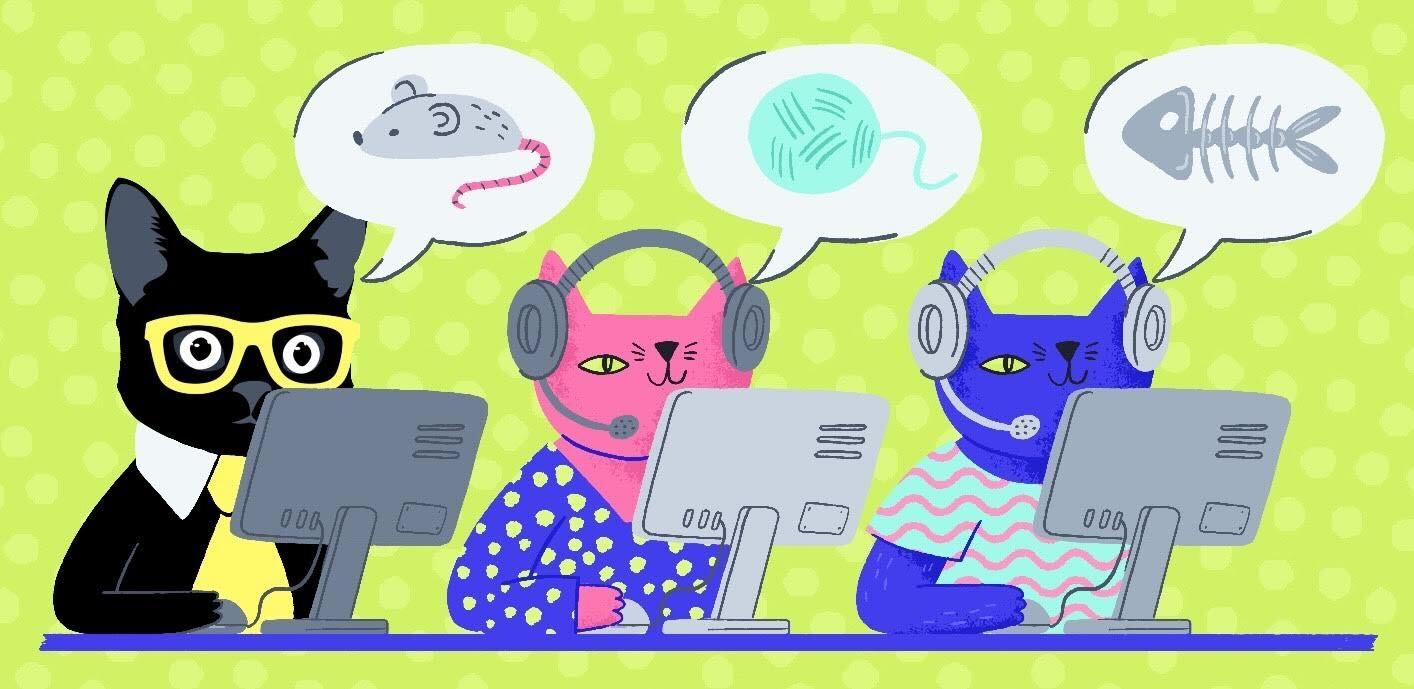Building any kind of high-performing team isn’t easy, but it’s always worth it. As customer service managers work to demonstrate the value of support-driven growth to their companies, they’re increasingly recognizing the part diverse customer support teams can play in boosting revenue and increasing customer loyalty, by creating authentic connections with customers.
Building support teams that are diverse in ethnicity, gender, age, ability, and socioeconomic status can have a real, measurable impact on your company’s competitiveness and bottom line.
From tabby-like talents to Siamese-style skills, embracing diversity isn’t just a trend — it’s the secret to delivering great customer service while fostering an environment where both agents and the company can thrive. If you’re a customer service manager who wants to build a strong support team, you came to the right place.

The benefits of diverse customer service representatives
Among the data backing up the benefits of diverse customer service agents, the statistic that ethnically diverse companies financially outperform their peers by 35% is probably the most well-known. But the paw-sitive impacts of diversity are actually greater than that.
Diverse companies are nearly twice as likely to be considered innovating leaders in their market, have 6% more revenue, and win 15% more customers than their competitors. This advantage is likely because diverse companies have a better understanding of who their customers are and what they want out of the company’s products and services. This kind of understanding helps in providing great customer service and has a direct impact on customer satisfaction.

Now that we know the benefits of building a diverse customer service department, it’s important to note that people aren’t diverse, teams are. We sometimes misuse the term diverse because we’re reluctant to address the real challenge out loud, for fear of sparking difficult conversations; our teams are often overwhelmingly white, overwhelmingly under 40, and overwhelmingly male.
If you’re serious about building a diverse customer service team (which you are, or you wouldn’t be reading this!), then you need to start by taking a sincere and critical look at your team as it is and be willing to have frank conversations about what you find.
If you determine that women, Black people, Latinx people, queer people, neurodivergent people, disabled people, people over 50, or single parents are underrepresented or have a high turnover rate on your support team, the first step toward fixing that is to say so.
As with all challenges, you need a clear and honest understanding of the situation. Once you’ve defined what diversity means for your specific customer service team, you can implement a strategy for recruiting those candidates, in turn helping your support team to flourish.

Best practices in hiring diverse customer service teams
So you’ve put in the work to define what diversity means to your team, and you’ve had thoughtful and productive conversations within your company about why it’s important that your customer service team reflects the broad variety of your customer base — great!
You’re ready for the next steps of your DEI journey, which are to connect with the communities you want to hire, revamp your hiring process to appeal to potential candidates and create systems that will reduce bias in your hiring.
Get your job listings in front of a diverse audience
The first scratch post to climb is getting your role in front of the folks you’re trying to recruit.
Thankfully, there are many communities out there eager to connect you with talented workers of every age, ethnicity, ability, and background. To get you started, here are some great job boards and organizations to consider posting your listings to or paw-tnering with:
- SquadJobs
- Blacks in Technology
- Wonder Women Tech
- Society for Advancement of Chicanos/Hispanics & Native Americans in Science
- Society of Hispanic Professional Engineers
- Hispanic / Latino Professionals Association
- American Indian Science and Engineering Society
- Jobs for Humanity
- Mentra
- Neurodiversity Career Connector
- Inclusively
- Chronically Capable
- Lime Connect
- Disability Job Board
- abilityJOBS
- The Mom Project
- Après
- PowerToFly
- Career Contessa
- Honest Jobs
- Jobs for Returning Citizens
- Felony Record Hub
- Trans*H4CK
- Pink Jobs
- Out and Equal
- AARP Jobs
- Hire Heroes USA
But just posting the customer service job on these job boards isn’t enough — your hiring process must invite and include the people you want to attract to your company.
Fortunately, there are some basic strategies you can employ to avoid driving away potential candidates.

Revamp your customer service job descriptions
First, review your job descriptions. Are you using gender-coded language like “aggressive” or “sensitive,” ageist language like “digital native,” or ableist language like “energetic”? Use the Conscious Style Guide to find and remove exclusionary language in favor of intentional inclusion.
You should also try to eliminate requirements that aren’t actually necessary in order for someone to be successful on your customer service team. For example, does your customer service representative really need a bachelor’s degree to do their job well? Do they really need to have high-level writing skills if they’ll primarily be offering phone support?
Do they really need to have worked in a startup if they can demonstrate experience working under pressure while serving customers in other ways, such as working in retail or food service?
Even better, focus less on a rote list of skills and experience a candidate should have and more on the work a candidate will actually need to do in the role. You could replace qualification lists with action- and results-oriented statements like:
- “In the first month, you will have learned how to use our quality assurance tool…”
- “In the first three months, you will have learned our product like an everyday user, and begun to identify gaps in our knowledge base and to write documentation to fill those gaps…”
- “In the first six months, you will have built good working relationships with our product team and developed a sustainable system for sharing impactful customer feedback…”
- “In the first year, you will have become an expert in our API, providing white-glove technical support to our Enterprise customers…”
These are of course fairly general examples, but writing job descriptions that focus on what the candidate will need to accomplish allows them to imagine themselves in the role and articulate how their abilities could fit in with and enhance your support team.

Implement strategies to reduce implicit biases in your support hiring
Lastly, recognize that we all have implicit biases, which are unconscious beliefs that affect how we behave and the decisions we make. If you don’t believe me, take one of Project Implicit’s Implicit Association Tests; you’ll likely find the results surprising.
Even when we’re aware of our biases, the very fact that they are so ingrained means they can influence our hiring decisions in ways that are subtle yet impactful. After all, we’re only feline-er, human. We’re definitely human.
That’s why it’s so important to have strategies in place that reduce implicit bias systematically.
It’s especially important early in the hiring process when candidates are often eliminated before they even talk to a human. A 2021 study in which researchers sent comparable resumes to 108 Fortune 500 companies found that applicants with Black-sounding names were called back 10% fewer times than applicants with white-sounding names.
That’s bias in action, and it can be mitigated by taking a few important steps:
- Anonymize candidate resumes. Have your HR team remove or black out identity cues from candidate applications before they’re sent to you. These cues include names, addresses, social media links, hobbies, and even their education, as these are hints at a candidate’s identity and can trigger affinity bias.
- Standardize and structure your interview process. Make sure each interviewer is trained and ask the same questions in the same order to every candidate, then use a cross-functional interview panel to evaluate candidates according to clear hiring criteria.
- Pare down the interview cycle and take-home projects. Interview processes that include more than four stages are rough for everyone, but especially for caregivers or candidates who are taking time off from another job to speak with you. Streamline your interview process to only what’s necessary to assess a candidate, including any take-home projects and, if you can, pay candidates for those projects.
No process will ever be perfect, but perfection isn’t the goal — the goal is to attract the right people and show them they can belong at your company.

How to manage diverse customer service teams
Of course, showing your team they belong at your company doesn’t end with hiring them — it only starts there.
Get to know your team members through one-on-ones
Get to know your customer support team personally and professionally through regular one-on-ones. What do your customer support agents think their strengths are? Where do they think they can improve? What are their career goals? What support do they need from you to be the best agent they can be?
Most importantly, use these one-on-ones to build trust and psychological safety with each person on your team. Psychological safety means that your team members can raise concerns, be vulnerable, and take risks without fear you’ll punish or reject them for doing so.
Make feedback a two-way street
Inviting feedback from your team members and then responding with respect and action are crucial when managing a diverse team — a McKinsey survey found that engaging with your team was “strongly linked with a sense of inclusion” and that customer service teams who felt their companies included them were more committed to their companies.
This data means you should also be open to adjusting your management style to meet the differing needs of your agents. While receiving feedback and mentoring is essential to a successful customer service team and career growth, what’s perfectly routine for some can be harrowing for others.
Black and Brown team members might have workplace trauma from receiving extra, unfair scrutiny from previous bosses, and neurodivergent team members may experience constructive criticism as painful rejection. Work together to develop processes that work for both of you.
Create (and use) consistent performance standards
A vital part of fostering belonging and excellence in your customer service team is establishing fair and transparent standards for performance and advancement. Your team should know what the expectations are for their roles, what the standards are for things like promotions and bonuses, and have equitable access to mentorship and coaching opportunities.
Apologize when you get it wrong
Finally, you shouldn’t expect to be a perfect leader. Perfection is the enemy of good, and that, as Public Allies so aptly puts it, “is a characteristic of white supremacy that holds everyone’s work to an unreasonable standard.”
Leading diverse customer service teams and coaching your agents are skills you have to learn and develop like any other. You’re going to make many mistakes, and that’s okay. Do your best to minimize harm and remember that, like a cat after a nap, growth requires stretching beyond your comfort zone.

Building a diverse team helps everyone win
Hiring and managing a diverse customer service team is hard work, but it’s work worth doing.
By celebrating differences and fostering a culture of inclusion, you’re not just building a remarkable team, you’re helping your customer service employees thrive, your customers feel delighted, and your organization flourish.
💡 If you want to learn more about how to build an incredible global customer service team, check out Glovo’s story. You’ll learn how they manage a huge team across 1500+ locations, how they structure customer service processes (including onboarding), and how they aim to exceed customer expectations, every time.


